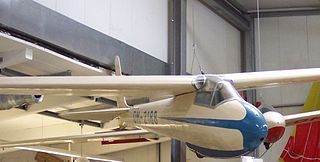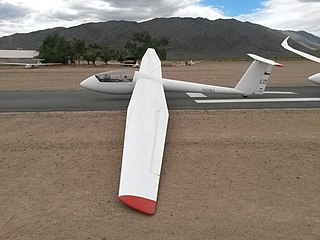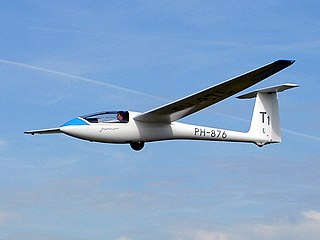
The DFS Olympia Meise was a German sailplane designed by the Deutsche Forschungsanstalt für Segelflug (DFS) for Olympic competition, based on the DFS Meise.

The Schempp-Hirth Discus is a Standard Class glider designed by Schempp-Hirth. It was produced in Germany between 1984 and 1995 but has continued in production in the Czech Republic. It replaced the Standard Cirrus. It was designed by Klaus Holighaus.

The ASK 13 is a two-seater glider that was built by German sailplane manufacturer Alexander Schleicher Gmbh & Co. It was and still is widely used for basic training of glider pilots.

The ASK 21 is a glass-reinforced plastic (GRP) two-seat glider aircraft with a T-tail. The ASK 21 is designed primarily for beginner instruction, but is also suitable for cross-country flying and aerobatic instruction.

The Politechnika Warszawska PW-6U is a Polish two-seat training sailplane designed at the Warsaw University of Technology for basic flight instruction and transition training to the PW-5 single-seater. It was manufactured at PZL Świdnik from 2000 and at ZS Jezow from 2007.

The ASW 24 is a modern single-seat high-performance composite Standard Class sailplane. It is manufactured in Germany by Alexander Schleicher GmbH & Co.

The PZL Bielsko SZD-50 Puchacz is a Polish two-place training and aerobatic sailplane.

The PZL Bielsko SZD-55 Nexus is a Standard Class sailplane produced by PZL Bielsko since 1988. It was built in direct competition with the Schempp-Hirth Discus. The SZD-55 is still in production with approximately 110 built.

The SZD-56 Diana is a 15 metre Class glider originally designed by Bogumił Bereś at PZL-Bielsko. However, PZL Bielsko went bankrupt before it could be put into serial production.

The PZL M-17 "Duduś Kudłacz" was a Polish twin-boom pusher general aviation and trainer aircraft of 1977, which remained a prototype.

The SZD-48 Jantar Standard 2 is a Standard Class glider that was designed and produced in Poland starting in 1977.

The Let L-33 Solo is a Czech shoulder-wing, single-seat, glider, designed by Marian Meciar and Vaclav Zajic, and produced by Let Kunovice. The L-33 first flew in 1992 and remained in production through 2012, supplied as a ready-to-fly aircraft.

A glider or sailplane is a type of glider aircraft used in the leisure activity and sport of gliding. This unpowered aircraft can use naturally occurring currents of rising air in the atmosphere to gain altitude. Sailplanes are aerodynamically streamlined and so can fly a significant distance forward for a small decrease in altitude.
The Applebay Zuni and Zuni II are single-seat, water-ballasted gliders designed to compete in the FAI 15m class.

The Politechnika Warszawska PW-2, also called the PW-2 Gapa, is a Polish lightweight high-wing, strut-braced single-seat, glider that was designed and built at the Warsaw University of Technology and also produced by DWLKK in the early 1990s. Total number of 19 gliders were built, including variant PW-2D bis.

The PZL Bielsko SZD-51 Junior is a Polish single-seat training and club sailplane.
The Roberts Cygnet is an American high-wing, cruciform tail, single-seat, glider that was designed and produced by Donald Roberts as a contender for the IGC World Class sailplane.

The Allstar SZD-54 Perkoz is a two-seater, glider for training, aerobatics, cross country flight and cloud flying from the Polish manufacturer Allstar PZL Glider. The sailplane has exchangeable wing tips for either 17.5 or 20 metres and is manufactured primarily from glass fibre reinforced plastic (GFRP). Without wing extension, it is certified for unlimited aerobatic manoeuvres. For glider training, the short wingspan is supplemented with winglets. As a cross-country glider with a 20 metres wing and winglets, the Perkoz has a glider index of 102. The SZD-54-2 Perkoz is the successor of the widely used SZD-50-3 Puchacz trainer, which is part of the SZD family of aircraft.

The Politechnika Warszawska PW-4 Pelikan was a motor-glider variant of the two seat Polish PW-3 Bakcyl glider. Only one flew.

















